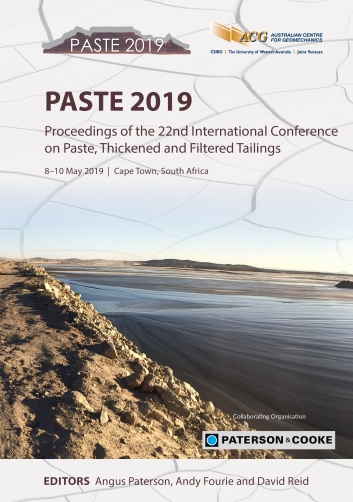The effect of preconditioning of tailings prior to inline flocculation and deposition

|
Authors: Torres Lopez, C; Catling, M; Bellwood, J; Boxill, L |
DOI https://doi.org/10.36487/ACG_rep/1910_19_Torres_Lopez
Cite As:
Torres Lopez, C, Catling, M, Bellwood, J & Boxill, L 2019, 'The effect of preconditioning of tailings prior to inline flocculation and deposition', in AJC Paterson, AB Fourie & D Reid (eds), Paste 2019: Proceedings of the 22nd International Conference on Paste, Thickened and Filtered Tailings, Australian Centre for Geomechanics, Perth, pp. 285-293, https://doi.org/10.36487/ACG_rep/1910_19_Torres_Lopez
Abstract:
Improving the dewatering characteristics of high solids tailings streams, by the addition of high molecular weight anionic polyacrylamides is known to be operationally challenging. This is particularly true in applications where a secondary flocculation occurs after primary treatment and thickening of a tailings stream – for example, underflow from a thickener or the dredging and re-treatment of unconsolidated material from a tailings dam. Previous experience has shown that high dosages of polymer are often required to increase the initial water release from the tailings on deposition and improve the longer-term consolidation of the deposit. This paper investigates the effect of preconditioning high solids tailings through the use of shear prior to flocculation with the aim of both reducing the overall polymer dose and improving the dewatering performance of the deposit. Data presented includes the effect of preconditioning on slurry rheology and initial water release of the polymer treated material. The work showed that in some circumstances, improvements may be achieved by applying an optimised level of pre-shear, but this is dependent upon the type and properties of the tailings. This study was undertaken on tailings slurries, from different mineral types, that have varying levels of clay and overall solids content.
Keywords: pre-shear, flocculation, tailings, water release
References:
Hogg, R 2000, ‘Flocculation and dewatering’, International Journal of Mineral Processing, vol. 58, pp. 223–236.
Kotlyar, LS, Sparks, BD, Woods, J, Capes, CE & Schutte, R 1995, ‘Biwetted ultrafine solids and structure formation in oil sands fine tailings’, Fuel, vol. 74, no. 8, pp. 1146–1149
Masliyah, J, Zhou, ZJ, Xu, Z, Czarnecki, J, & Hamza, H 2004, ‘Understanding water-base-bitumen extraction from Athabasca oil sands’, Canadian Journal of Chemical Engineering, vol. 82, pp. 628–654.
Reid, C, Bécaert, V, Aubertin, M, Rosenbaum, RK & Deschênes, L 2009, ‘Life cycle assessment of mine tailings management in Canada’, Journal of Cleaner Production, vol. 17, no. 4, pp. 471–479.
Stocks, P 2006, ‘Reagents’, in RJ Jewell & AB Fourie (eds), Paste and Thickened Tailings - A Guide, Australian Centre of Geomechanics, Perth.
Vajihinejad, V & Soares, JBP 2018, ‘Monitoring polymer flocculation in oil sands tailings: A population balance model approach’, Chemical Engineering Journal, vol. 346, pp. 447–457.
Van Olphen, H 1977, An Introduction to Clay Colloid Chemistry, National Academy of Sciences, Washington DC.
Vedoy, DRL & Soares, JBP 2015, ‘Water-soluble polymers for oil sands tailing treatment: a review’, The Canadian Journal of Chemical Engineering, vol. 93, pp. 888–904.
Walker, S 2015, ‘Tailings management strategies to meet today's demands’, Engineering & Mining Journal, vol. 216, no. 11,
pp. 44–49.
© Copyright 2025, Australian Centre for Geomechanics (ACG), The University of Western Australia. All rights reserved.
View copyright/legal information
Please direct any queries or error reports to repository-acg@uwa.edu.au
View copyright/legal information
Please direct any queries or error reports to repository-acg@uwa.edu.au


